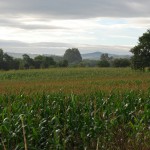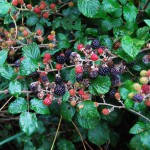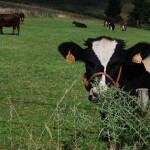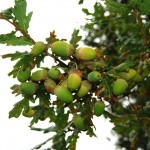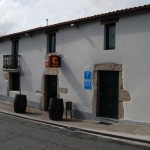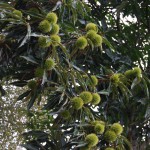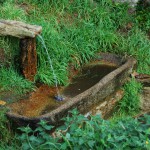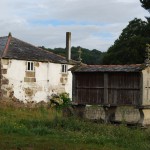Travelling in Spain: Camino Lugo—Santiago de Compostela. Part Four
We were awakened by the cows’ lowing and the pig’s squealing. The morning in rural Galicia starts with feeding the domestic animals. The whole neighbourhood was drowning in a thick mist. Our breakfast consisted of the traditional Galician dishes, already familiar to us – homemade bread, homemade slightly dried cheese, jamón, and omelette tortilla, plus the traditional cafe cortado (espresso with a small amount of milk). One cannot think of a better and healthier food for a walking pilgrim. After having a substantial breakfast and saying goodbye to our hospitable and generous hosts, we continued our journey.
As we crossed a stone bridge of Roman times, we turned to the road, marked by the signs familiar to us. And, as always, according to our old good tradition, we had to climb an ascent. Our path was going through the blackberry bushes, and as we went along, we could not help picking the ripe and sweet berries.
The mist was gradually clearing away, and the sun came out; everything around us sparkled and the dew turned into a blanket of diamonds. The path brought us onto a small country road. Cornfields and fields of potatoes were interchanged with eucalyptus and oak groves, and the oak trees were full of acorns. Because of acorns, Spanish jamon is so tasty and fragrant, and Spanish piggies enjoy a well-fed and happy life. Why would not they be happy, having such delicacies?
Unnoticed to ourselves, we passed through several small but quite ancient villages. Along the way, we sometimes ran into springs and horreos, as well as herds of grazing cows. It was amazing to watch, how the grazing cows, as we approached them, suddenly stopped grazing and looked up at us, as if they were expecting something from us. For over a thousand years of history of Camino, the domestic animals developed a unique, typical only for these domestic animals, reflex. The pilgrims, as they passed by on their Camino, greeted the cow’s owners, who tended their herds, and the animals, reacting to the voice of their masters, instinctively raised their heads, expecting to get some treat. And this is true not only with the cows; the sheep, pigs, cats, and dogs behave in the same manner. It was the most unexpected discovery for us.
As we approached the destination of the second day of our pilgrimage, we looked into one roadside shop, where, according to what Slava Kim had told us, they sold ancient brandy in mouldy bottles. In the shop we were greeted by the business’ owners – a father and his son. To our request to show us their “treasures” they gladly responded, and started taking out from their stores ancient bottles, on some of which we could still see the labels. There was brandy in all the bottles. Eventually we found out that all this brandy was not that old, it was bottled in the 1980s, and all the time it had been kept in the cellars. When it was bottled, some brandy was ten to twenty years old, which is not anything special. After spending in the cellar thirty more years, it aged, and the content of some of the bottles was a witness of the history of the past century. Naturally, you do not always get such a unique chance, and we all “stocked up” on these rarities. The shop’s owners, recognizing us as gourmands, as a sign of gratitude for the purchases we made, decided to treat us to their special “elixirs” — homemade vodka and liqueur made of medicinal herbs infused in homemade vodka. After we accepted the treat, and had a cordial chat with our new friends, we went on to our hotel, where we had planned a royal dinner.
Absorbed in our conversation and thoughts, we did not notice how we came to our hotel. The hotel «O Pino» was situated on an elevation, next to a busy intersection. The hotel was adjoined by a shady inner yard, overgrown with vines. The hotel is praised by the local people and travellers for its restaurant, in which traditional Galician dishes are served in chef’s unique interpretation. The restaurant is also famous in its neighbourhood by its wine menu, which contains over a hundred sorts of local wine.
After having some rest and brushing up, we came down to the restaurant, where it was all packed full. At the entrance to the restaurant there was a showcase, where some souvenirs and trophies from all over the world were displayed. This is a good sign, showing that the food here is great. According to the established restaurant tradition, we were served local mineral water and offered our menus. The menu was so diverse, that we had to ask our Spanish guide Andrei for advice, and he helped us to choose our dishes and select the wines for them.
Following Andrei’s advice, we ordered an assortment of seafood on grill, several traditional fish dishes, and an assortment of various tapas. All the culinary pleasures were served with white wine. For dessert we were offered Tarta de Almendras (or Santiago pie), which is an almond cake, orange soufflé, and coffee flan.
When we enjoyed the delicacies and masterpieces of culinary art, and thanked the cooks and waiters, we went to have some rest. Ahead of us there was the last, third day of our Camino.

